Designing a small bathroom can be a challenging task, but it doesn’t mean you have to sacrifice style or functionality. With the right design solutions, you can create a small bathroom that has a big impact. Here are some creative design solutions for limited space.
Use Wall-Mounted Fixtures
In the quest to maximise space and functionality in a small bathroom, wall-mounted fixtures emerge as a prime solution. These fixtures, affixed directly to the wall, eliminate the need for bulky supports or pedestals, freeing up valuable floor space and contributing to a cleaner, more open aesthetic. From sinks and toilets to cabinets and shelving, wall-mounted options are available in a variety of styles and configurations, allowing for personalisation and efficient space utilisation. By elevating these essential components, you not only gain floor space but also create an illusion of expansiveness, making your small bathroom appear larger and more inviting.
Types of Wall-Mounted Fixtures:
- Sinks: Wall-mounted sinks can range from sleek, minimalist designs to more elaborate basins with built-in storage or counter space. They eliminate the need for a vanity unit, opening up the floor and creating a more airy feel.
- Toilets: Wall-mounted toilets have the cistern concealed within the wall, saving space and enhancing the bathroom’s modern aesthetic. They are easier to clean around and can be installed at a custom height for comfort and accessibility.
- Storage Units: Wall-mounted cabinets and shelves utilise vertical space for storage, keeping your essentials organised and accessible without cluttering the floor. Open shelving can also create a sense of openness, while cabinets offer concealed storage for a tidy look.
Design and Aesthetic Benefits:
- Streamlined Look: Wall-mounted fixtures contribute to a sleek, uncluttered design, accentuating the visual flow and making the bathroom appear more spacious.
- Customisable Height: Since these fixtures are not bound to the floor, they can be installed at varying heights to suit your ergonomic needs and design preferences, creating a tailored and comfortable environment.
Space Optimisation Strategies:
- Corner Solutions: Consider installing wall-mounted fixtures in corners to maximise space efficiency. Corner sinks or shelving can fit snugly into areas that are often under-utilised.
- Multipurpose Fixtures: Look for wall-mounted options that serve multiple purposes, such as a sink with integrated towel rails or storage compartments, to further maximise the utility of every square inch.
Installation Considerations:
- Structural Support: Ensure that your bathroom walls can support the weight of wall-mounted fixtures. Reinforcement may be needed, especially for heavier items like toilets or large cabinets.
- Plumbing and Electrical: Consult with professionals about the plumbing and electrical implications of installing wall-mounted fixtures. Concealed plumbing and wiring require careful planning and execution.
Maximising Floor Visibility:
- Continuous Flooring: With fixtures off the floor, you can have continuous flooring that extends throughout the bathroom, enhancing the sense of space and ease of cleaning.
- Cleaning Convenience: Wall-mounted fixtures allow for easy floor cleaning, as there are fewer nooks and crannies where dirt and moisture can accumulate.
Professional Advice and Installation:
- Consult with Designers and Contractors: Before embarking on the installation of wall-mounted fixtures, consult with bathroom design professionals and contractors. They can provide valuable insights into the best products for your space, structural considerations, and aesthetic options.
- Quality Fixtures: Invest in high-quality wall-mounted fixtures that are designed for longevity and ease of use. Durable materials and reliable mounting systems are crucial for long-term satisfaction and safety.
Wall-mounted fixtures offer a smart and stylish way to make the most of a small bathroom. By freeing up floor space and creating a more open feel, these fixtures can transform a cramped bathroom into a comfortable and visually appealing space. With careful selection, customisation, and professional installation, wall-mounted sinks, toilets, and storage units can significantly enhance the functionality and aesthetics of your bathroom, proving that even the smallest spaces can have a big impact.
Learn More About 5 Tips for an Age-Friendly Bathroom Remodel
Choose a Compact Tub or Shower
In smaller bathrooms, every inch counts, and choosing the right tub or shower can make a significant difference in the overall feel and functionality of the space. Compact tubs and showers are specifically designed to fit into tighter areas without sacrificing comfort or style. By opting for models that are tailored for small spaces or innovative corner units, you can enjoy the luxury of a relaxing bath or a refreshing shower without overwhelming the room. These space-saving solutions come in a variety of designs, allowing you to find the perfect match for your bathroom’s aesthetic and your personal needs.
 Types of Compact Tubs and Showers:
Types of Compact Tubs and Showers:
- Corner Units: Corner tubs and showers are excellent space-savers, tucking neatly into an often under-utilised area of the bathroom. Their angled design opens up the centre of the room, creating a more spacious feel.
- Narrow or Short Tubs: Look for tubs that have a reduced length or width but are still deep enough for a comfortable soak. Some models are designed to fit into alcoves or against a single wall.
- Walk-in Showers: A walk-in shower with a clear glass enclosure or an open design can make the bathroom appear larger while providing a sleek and modern look.
Design and Functionality:
- Style Compatibility: Compact tubs and showers come in various styles, from modern and minimalist to traditional and ornate. Choose a design that complements the rest of your bathroom’s decor.
- Ergonomic and Efficient Features: Despite their smaller size, many compact units come equipped with features such as built-in seating, shelves, or hydrotherapy jets, ensuring that they are as functional as they are space-efficient.
Maximising Space Perception:
- Glass Enclosures: Using clear glass for shower enclosures can visually expand the space by allowing sightlines to continue uninterrupted. Frosted or textured glass can provide privacy while still keeping the space open and light.
- Mirrored or Reflective Surfaces: Incorporate mirrors or reflective tiles around the tub or shower area to bounce light around the room and create an illusion of more space.
Installation Considerations:
- Professional Measurement and Installation: Ensure accurate measurements and professional installation, particularly for corner units or custom designs, to maximise space efficiency and avoid costly mistakes.
- Quality Materials: Choose durable and easy-to-clean materials that will maintain their appearance and functionality over time, even in the more compact format.
Integrating with the Overall Design:
- Coordinated Fixtures and Accessories: Match your tub or shower fixtures and accessories with the rest of the bathroom to create a cohesive look. Consider space-saving accessories like corner shelves or wall-mounted soap dishes.
- Colour and Tile Choices: Light colours and larger tiles can make the space feel larger, while darker or busier patterns might be used to create a focal point or accent.
Personalisation and Comfort:
- Customisable Options: Look for compact tubs or showers that offer customisable options, such as removable or adjustable showerheads, different colour finishes, or additional storage solutions.
- Comfort Features: Don’t compromise on comfort. Even compact models can be designed for relaxation and enjoyment, with ergonomic shapes, non-slip surfaces, and other user-friendly features.
Choosing a compact tub or shower is a key strategy in making the most of a small bathroom. With the right design and thoughtful integration into your space, these fixtures can provide all the functionality and comfort you need without cluttering the room. By considering types, design, space perception, installation, and personalisation, you can transform your bathroom into a more efficient, stylish, and enjoyable space. Compact tubs and showers prove that even in the smallest bathrooms, you can create a big impact with the right design solutions.
Discover More About The Pros and Cons of Trendy vs. Timeless Bathroom Designs
Utilise Vertical Space
In small bathroom designs, where the footprint is limited, leveraging vertical space is a critical strategy to enhance functionality and aesthetics. By directing attention upwards and making use of the walls and height of the room, you can significantly increase storage capacity, reduce clutter, and create a more spacious feeling. Vertical storage solutions, such as shelves, cabinets, and tall units, provide ample opportunity to organise bathroom essentials while contributing to an overall sense of order and spaciousness. Embracing the vertical dimension opens up a wealth of possibilities for creative and efficient use of space.
 Strategies for Maximising Vertical Space:
Strategies for Maximising Vertical Space:
- Tall Shelving Units: Install tall shelving units that reach near the ceiling, providing plenty of storage for towels, toiletries, and decorative items without taking up much floor space.
- Wall-Mounted Cabinets: Use the area above the toilet or sink for wall-mounted cabinets. These can hold a surprising amount of items and keep the clutter out of sight, contributing to a cleaner and more open space.
- Hanging Solutions: Consider hanging storage solutions like floating shelves, wall hooks, or over-the-door organisers for frequently used items. This keeps essentials within reach while maintaining a tidy appearance.
Design Considerations for Vertical Storage:
- Open vs. Closed Storage: Open shelves can make the space feel more open and airy, while closed cabinets can hide away clutter. Consider a mix of both depending on your storage needs and aesthetic preferences.
- Material and Style Consistency: Ensure that the materials and style of your vertical storage solutions are consistent with the rest of the bathroom design. Cohesive design elements contribute to a harmonious and spacious feel.
Enhancing Space Perception:
- Mirrored or Reflective Surfaces: Incorporate mirrors or reflective materials in your vertical storage units to amplify light and create an illusion of more space.
- Colour and Lighting: Light colours can make the space feel larger and more open. Consider integrated lighting solutions in shelving or cabinets to highlight items and add depth.
Customisation and Flexibility:
- Adjustable Shelving: Use adjustable shelving systems that can be reconfigured as your storage needs change. This flexibility allows you to customise the space for different items and purposes over time.
- Multifunctional Units: Look for vertical storage units that offer multifunctionality, such as a cabinet with a built-in mirror or a shelving unit that includes a towel bar.
Professional Tips for Vertical Storage:
- Maximising Height: Work with interior designers or organisation experts to identify ways to maximise the height of your bathroom for storage. They can provide insights into innovative storage solutions and layout optimisations.
- Quality and Installation: Invest in high-quality materials and ensure professional installation, especially for units that extend to the ceiling. Properly secured storage is essential for both functionality and safety.
Utilsing vertical space is a transformative approach to managing small bathrooms. By incorporating tall shelving, wall-mounted cabinets, and other vertical storage solutions, you can dramatically increase your storage capacity, reduce clutter, and enhance the overall sense of space. With careful consideration of design, customisation, and professional guidance, vertical storage can make your small bathroom not only more organised but also more visually appealing and spacious.
Read More on Designing a Spa-Like Bathroom Retreat on a Budget
Use Mirrors
In the design toolkit for small bathrooms, mirrors are a potent ally. They do more than facilitate daily routines; they expand visual space, reflect light, and contribute to a brighter, more expansive atmosphere. By carefully choosing and placing mirrors, you can transform the perception of your bathroom’s size, making it feel larger and more luxurious. Whether you opt for one large statement mirror or an arrangement of several smaller ones, the reflective quality of mirrors can significantly open up your space and enhance its aesthetic appeal.
Enhancing Space with Mirrors:
- Strategic Placement: Position mirrors to maximise their impact. Placing a large mirror on the wall opposite the door or window can instantly double the visual space and light. For smaller bathrooms, consider covering a whole wall with a mirror.
- Reflecting Light: Mirrors excel in bouncing light around the room. Place them opposite or adjacent to windows or light sources to amplify natural and artificial light, brightening the entire space.
Design and Style Considerations:
- Complementary Framing: Choose frames that complement the overall design of your bathroom. Sleek, frameless mirrors suit modern, minimalist aesthetics, while ornate frames can add a touch of elegance to traditional decors.
- Shape and Size: Experiment with different shapes and sizes to add interest or to fit specific areas of your bathroom. Round mirrors can soften the space, while elongated or custom shapes can add a unique touch.
Creating a Focal Point:
- Statement Mirrors: A single, large mirror can serve as a focal point, especially when it features an interesting shape or elaborate frame. It draws the eye and adds a sense of depth.
- Multiple Mirrors: Arranging several smaller mirrors creatively can not only enhance the sense of space but also serve as a decorative element, adding personality to your bathroom.
Maximising Functionality:
- Illuminated Mirrors: Consider mirrors with built-in lighting for an added functional and aesthetic benefit. They provide excellent task lighting and contribute to the overall ambiance.
- Storage Integration: Look for mirrors with integrated storage solutions like hidden medicine cabinets or shelves. This helps maintain a clutter-free environment while maximising space efficiency.
Installation and Quality:
- Professional Installation: Ensure mirrors are securely installed, particularly larger pieces. This prevents accidents and maintains the integrity of the design.
- Quality Reflective Surfaces: Invest in mirrors with high-quality reflective surfaces. Good quality mirrors provide clear reflections and maintain their look over time without delivering or clouding.
Considerations for Small Bathrooms:
- Scale and Proportion: Ensure the size of the mirror is proportionate to your bathroom. Too large might overwhelm the space, while too small might not create the desired effect.
- Versatile Shapes: Don’t be afraid to use non-traditional shapes or designs. Mirrors are versatile elements that can adapt to various spaces and styles.
Mirrors are a vital element in creating a sense of spaciousness in small bathrooms. With strategic placement, thoughtful selection, and creative arrangement, mirrors can dramatically enhance the perception of space, reflect light, and add a touch of style. They are not just functional items but powerful design tools that can transform the look and feel of your bathroom, making it brighter, larger, and more inviting. By utilising mirrors effectively, you can make a significant impact even in the most limited spaces.
Find Out About The Benefits of an Open-Concept Bathroom Design
Consider Pocket Doors
In the realm of small bathroom optimisation, pocket doors emerge as a highly effective solution for conserving space and enhancing functionality. Unlike traditional swing doors, pocket doors slide into a compartment in the adjacent wall, virtually disappearing when open. This feature eliminates the need for clearance space for the door arc, freeing up precious square footage and improving the flow within the bathroom. Whether used for the main bathroom entrance or for individual enclosures within the space, such as shower or toilet areas, pocket doors offer a sleek, space-saving alternative to conventional doors.
Maximising Space with Pocket Doors:
- Space Efficiency: By eliminating the swing area needed for traditional doors, pocket doors free up floor space, allowing for more flexible placement of fixtures and furnishings.
- Improved Layout: The additional space can be used to enhance the bathroom layout, perhaps allowing for a larger shower, extra storage, or a more spacious vanity area.
Design and Aesthetic Benefits:
- Sleek Appearance: Pocket doors offer a clean, unobtrusive look that complements a variety of design styles, from modern minimalism to classic elegance.
- Customisable Options: Pocket doors come in a range of materials, finishes, and designs, allowing you to choose an option that fits your bathroom’s aesthetic and functional needs.
Functional Considerations:
- Ease of Access: Pocket doors can be easier to operate in tight spaces, making them a practical choice for small bathrooms.
- Privacy and Sound Insulation: Consider the type of pocket door and hardware to ensure adequate privacy and sound insulation for the bathroom. Some doors come with specialised seals and soundproofing materials.
Installation and Planning:
- Structural Requirements: Installing a pocket door involves creating a cavity within the wall to house the door when open. Ensure your bathroom walls can accommodate this, and consult with professionals for proper installation.
- Quality Hardware: Invest in quality sliding mechanisms and handles for smooth operation and durability. High-quality hardware can prevent common issues such as door sticking or alignment problems.
Versatility in Use:
- Main Entrance: A pocket door for the main bathroom entrance is an excellent way to save space in both the bathroom and adjacent areas.
- Internal Enclosures: Within the bathroom, pocket doors can be used for separate toilet compartments or shower enclosures, maintaining an open feel while providing privacy when needed.
Accessibility and Comfort:
- Considerations for All Users: Ensure that the pocket door is easily operable by all potential users, including children, the elderly, or those with mobility issues. Handles and locks should be comfortably reachable and easy to use.
- Maintenance Access: While pocket doors are space-efficient, they can be more challenging to maintain due to the concealed track system. Choose a system that allows for easy access for adjustments and repairs.
Professional Advice:
- Consult with Designers and Contractors: Before deciding on a pocket door, consult with design and construction professionals. They can advise on the feasibility, provide design options, and ensure that the installation is carried out correctly.
- Building Codes and Regulations: Be aware of any building codes or regulations that might affect the installation of a pocket door, especially concerning structural alterations and fire safety.
Considering pocket doors is a smart move for anyone looking to maximise the space and functionality of a small bathroom. With their space-saving design, aesthetic flexibility, and functional benefits, pocket doors can significantly enhance the comfort and usability of your bathroom. By carefully selecting the right door, planning for efficient installation, and ensuring accessibility for all users, you can enjoy the increased space and improved flow that pocket doors provide, making your small bathroom feel more open, accessible, and comfortable.
Dive Into Tips for Maximising Natural Light in Your Bathroom Remodel
Choose Light Colours
In the visual orchestration of a small bathroom, the colour palette plays a crucial role in determining the overall perception of space. Light colours, known for their ability to reflect light and create a sense of openness, are particularly effective in small environments. By opting for shades of white, beige, or light grey, you can significantly brighten the space and make it feel more expansive. These hues act as a visual expander, pushing back the walls and lifting the ceiling, transforming your compact bathroom into a serene and airy retreat.
 Benefits of Light Colours:
Benefits of Light Colours:
- Enhanced Brightness: Light colours reflect more natural and artificial light, making the bathroom brighter and more welcoming. This increased luminosity can make the space feel larger and more open.
- Visual Continuity: Using a uniform light colour or similar shades throughout the bathroom creates a seamless look that enhances the sense of space. Continuous colour reduces visual fragmentation and makes the room appear more expansive.
Choosing the Right Shades:
- Neutral Palette: White, beige, and light grey are popular choices for creating a neutral and versatile backdrop. These colours are timeless and can easily be accented with different colours and textures.
- Warm or Cool Tones: Depending on the desired atmosphere, choose between warm or cool light hues. Warm tones add coziness, while cool tones create a more refreshing and open feel.
Maximising the Effect of Light Colours:
- Glossy Finishes: Consider using glossy finishes on tiles, fixtures, or paint. The reflective surface of glossy finishes can further enhance the light-reflecting properties of light colours.
- Colour Coordination: Coordinate the colours of walls, floors, fixtures, and textiles to maintain a cohesive look. This coordination helps in creating a unified and spacious feel.
Design Strategies:
- Layering of Textures: Add interest and depth to a light-coloured bathroom by incorporating a variety of textures. Use tiles, fabrics, and finishes with different patterns and tactile qualities to enrich the visual experience without overwhelming the space with colour.
- Accent Elements: While keeping the base colour light, introduce accent colours through accessories, towels, or artwork. These pops of colour can add personality and focus without sacrificing the openness created by the light palette.
Considerations for Small Bathrooms:
- Maintenance and Cleanliness: Light colours, especially white, can make dirt and stains more visible. Choose materials and finishes that are easy to clean and maintain to keep the bathroom looking fresh and bright.
- Balancing Light and Shadow: Ensure that the bathroom is well-lit to maximise the benefits of light colours. Consider the placement of lighting fixtures to avoid casting shadows that could diminish the sense of space.
Professional Advice and Inspiration:
- Consult Design Experts: Speak with interior designers or colour consultants to find the perfect shade and finish for your space. They can provide valuable insights into colour psychology and the latest trends.
- Explore Visual Resources: Look at design magazines, websites, or showrooms to see how light colours have been effectively used in other small bathrooms. Gathering inspiration can help you visualise the potential for your own space.
Choosing light colours for your small bathroom is a strategic decision that can have a profound impact on the overall feel of the space. Light hues like white, beige, and light grey are excellent for creating a sense of openness, brightness, and continuity. By thoughtfully selecting shades, finishes, and coordinating elements, you can transform your compact bathroom into a spacious, airy haven. With the right approach to colour, even the smallest bathrooms can exude comfort, style, and a feeling of expansiveness.
Uncover Details on How to Choose the Right Colour Scheme for Your Bathroom Renovation
Add Colour and Texture with Accessories
In small bathroom spaces, where every detail counts, accessories play a pivotal role in defining the style and personality of the area. While maintaining a light and airy base palette, introducing pops of colour and layers of texture through accessories can invigorate the space without overwhelming it. Colourful towels, patterned shower curtains, and textured rugs are just a few examples of how accessories can add depth, interest, and personal flair to your bathroom. These elements allow you to infuse character and warmth into the space, making it feel uniquely yours while keeping it functional and stylish.
Injecting Colour and Vitality:
- Colourful Towels: Towels are not only functional but also an easy way to introduce colour. Choose shades that complement or contrast with the bathroom’s colour scheme to make a statement or create harmony.
- Accent Decor: Items like vases, soap dispensers, or artwork can serve as focal points of colour. These small but impactful touches can be easily changed to refresh the look or match seasonal themes.
Incorporating Texture for Depth:
- Textured Towel Rugs: A plush, textured rug can add warmth and comfort underfoot while contributing a layer of texture and colour. Choose materials that are absorbent and quick-drying for practicality and long-lasting appeal.
Balancing Accessories for Cohesion:
- Coordinated Sets: Consider coordinating accessory sets where colours and patterns harmonise for a cohesive look. Matching sets can unify the design and make the space feel orderly.
- Thematic Consistency: Ensure that the accessories fit within the overall theme or style of your bathroom. Whether it’s nautical, botanical, or minimalist, keeping a consistent theme helps in creating a deliberate and designed feel.
Personalisation and Flexibility:
- Reflecting Personal Style: Use accessories as a means of expressing your individual style and preferences. They’re an easy way to personalise the space without permanent changes.
- Rotating Decor: One of the advantages of accessories is their flexibility. Rotate towels, decor items, or rugs periodically to keep the bathroom feeling fresh and updated.
Maximising Space with Accessories:
- Vertical Storage: Use vertical space for storage of colourful and textured items. Wall-mounted baskets, hanging plants, or open shelves can display accessories without cluttering the floor.
- Multi-Functional Accessories: Choose accessories that are both decorative and functional, like a stylish hamper or a decorative stool that offers seating or surface space.
Quality and Durability:
- Invest in Quality: Choose accessories that are durable and high-quality. In a small space, each item is noticeable, so well-crafted pieces can significantly enhance the overall look.
- Easy to Clean: Since bathrooms are high-moisture environments, opt for accessories that are easy to clean and resistant to mildew or wear.
Adding colour and texture with accessories is a simple yet effective way to enhance the aesthetic appeal of your small bathroom. By carefully selecting towels, curtains, rugs, and other decorative items, you can create a space that reflects your personal style and adds visual interest without sacrificing space or functionality. Accessories offer the flexibility to change the look and feel of your bathroom with minimal effort, making them a perfect solution for keeping your small bathroom vibrant, stylish, and uniquely yours.
Explore Further about How to Make the Most of Your Bathroom Layout
Install Efficient Lighting
Effective lighting is crucial in transforming the atmosphere and functionality of a small bathroom. In compact spaces, where every design element counts, efficient lighting can make a significant difference by creating a bright, welcoming environment. A thoughtful combination of overhead, task, and accent lighting not only illuminates the space but also enhances its aesthetic appeal and functionality. By maximizing available light and employing energy-efficient solutions, you can ensure your small bathroom is both beautifully lit and environmentally conscious.
Types of Lighting for Small Bathrooms:
- Overhead Lighting: Start with a central overhead light to provide ambient lighting that fills the entire room. Consider a flush or semi-flush mount fixture to maintain clearance in smaller spaces.
- Task Lighting: Install task lighting near the mirror or vanity area to provide focused illumination for grooming activities. Sconces or vertical fixtures on either side of the mirror can offer shadow-free lighting.
- Accent Lighting: Use accent lighting to highlight architectural features, artwork, or decorative elements. Small LED recessed lights or strip lighting can add a touch of drama and dimension.
Maximizing Light Efficiency:
- LED Bulbs: Opt for LED bulbs, which are energy-efficient and have a longer lifespan than traditional bulbs. They provide bright, clear light and come in various colour temperatures to suit the mood you want to create.
- Dimmers: Install dimmers to control the intensity of the light. Being able to adjust the brightness not only saves energy but also allows you to create different atmospheres depending on the time of day or desired ambiance.
- Reflective Surfaces: Enhance the effectiveness of lighting by incorporating reflective surfaces like mirrors, glossy tiles, or shiny fixtures that bounce light around the room, making it appear brighter and larger.
Designing with Light in Mind:
- Layered Lighting: Combine different types of lighting to eliminate shadows and evenly distribute light throughout the space. A well-layered lighting plan can enhance the room’s dimensions and textures.
- Colour Temperature: Choose the right colour temperature for your bulbs. Warmer tones (2700K – 3000K) create a cozy and inviting atmosphere, while cooler tones (3500K – 4100K) are energising and better for task lighting.
- Light Placement: Pay attention to the placement of fixtures. Properly positioned lighting can visually expand the space, accentuate design elements, and improve the overall functionality of the bathroom.
Innovative Lighting Solutions:
- Smart Lighting: Consider smart lighting systems that can be controlled remotely or programmed to adjust throughout the day. These systems offer convenience, efficiency, and the ability to customise lighting scenes easily.
- Integrated Lighting: Look for opportunities to integrate lighting into other elements, such as illuminated mirrors, under-cabinet lights, or within shower enclosures, for a sleek and modern look.
Safety and Installation Considerations:
- Professional Installation: Ensure that all lighting is installed by a qualified electrician, especially in the damp bathroom environment. Proper installation is key to safety and functionality.
- Waterproof Fixtures: For lighting in wet areas, such as close to the shower or tub, make sure to use waterproof or appropriately rated fixtures to prevent damage and ensure longevity.
Installing efficient lighting is a transformative move for small bathrooms, offering a way to create a bright, inviting, and functional space. By combining overhead, task, and accent lighting, you can illuminate every corner of the bathroom, making it feel larger and more welcoming. With the addition of energy-efficient bulbs, dimmers, and innovative lighting solutions, your bathroom lighting can be both beautiful and smart, providing the perfect ambiance while conserving energy. Embrace the power of light to make your small bathroom a shining example of style and efficiency.
Investigate 10 Steps for Creating a Cohesive Design Plan for Your Bathroom Renovation
Utilise Hidden Storage
In the quest to declutter and maximise space in a small bathroom, hidden storage emerges as a clever and effective strategy. By integrating storage into the existing structure and furnishings of the bathroom, you can keep essentials organised and accessible without compromising the room’s visual openness and mobility. Hidden storage solutions, such as mirrored medicine cabinets or built-in wall units, provide the necessary space for toiletries, linens, and other bathroom items while maintaining a sleek, uncluttered appearance. This approach to storage combines functionality with a seamless aesthetic, making your small bathroom both practical and stylish.
 Innovative Hidden Storage Solutions:
Innovative Hidden Storage Solutions:
- Mirrored Medicine Cabinets: A classic solution, mirrored medicine cabinets offer storage space behind what appears to be just a mirror. This dual-purpose fixture is ideal for storing small items and keeping countertops clear.
- Recessed Wall Cabinets: Utilise the space inside your bathroom walls by installing recessed cabinets. They sit flush with the wall, providing storage without encroaching on the room’s footprint.
- Under-Sink Storage: Maximise the space under the sink with hidden drawers or a cabinet. Custom fit around the plumbing, these solutions can neatly conceal bathroom necessities.
Designing for Cohesion and Ease of Access:
- Coordinated Finishes: Ensure that the hidden storage complements the overall design of the bathroom. Match the finishes, colours, and styles to the rest of your decor for a cohesive look.
- Convenient Access: While the goal is to conceal storage, make sure that it remains easily accessible. Use hardware and opening mechanisms that allow for smooth operation and easy reach.
Maximising Every Inch:
- Custom Solutions: Consider custom-built hidden storage tailored to your specific needs and bathroom dimensions. Custom solutions can optimise even the smallest or most awkwardly shaped areas.
- Multi-functional Fixtures: Look for fixtures that serve more than one purpose, such as a vanity with built-in hidden compartments or a bathtub with integrated storage panels.
Enhancing Space Perception:
- Streamlined Surfaces: Hidden storage allows for cleaner lines and surfaces in the bathroom. This reduction in visible clutter contributes to a more spacious and tranquil atmosphere.
- Strategic Placement: Position hidden storage in areas that are usually underutilised, such as above the toilet, inside shower walls, or in the base of a vanity.
Considerations for Hidden Storage:
- Balance Between Concealment and Convenience: While the aim is to hide storage, ensure that it doesn’t become inconvenient to access frequently used items. Plan for a mix of hidden and open storage for different types of items.
- Quality and Durability: Choose durable materials and hardware for your hidden storage, ensuring that it withstands frequent use and the humid bathroom environment.
Professional Planning and Installation:
- Expert Advice: Consult with interior designers or contractors who can advise on the best hidden storage solutions for your space, taking into account structural considerations and design preferences.
- Precision Installation: Hidden storage often requires precise installation, especially if it involves cutting into walls or custom-fitting units. Professional installation is crucial for a seamless look and long-term functionality.
Utilising hidden storage is a smart way to enhance the functionality and aesthetic of a small bathroom. By integrating storage into the structure and furnishings, you can significantly reduce clutter and maintain a spacious feel. With innovative solutions like mirrored medicine cabinets, recessed wall units, and under-sink drawers, along with careful planning and professional implementation, your small bathroom can achieve a balance of style, spaciousness, and organisation. Embrace hidden storage as a key element in your quest to create a more efficient and appealing bathroom space.
Delve Into Top Bathroom Design Trends to Consider for Your Remodel in 2024
Work with a Professional
Working with a professional bathroom renovation contractor or designer can help ensure that your small bathroom remodel meets your needs and reflects your personal style. Look for a professional with experience in small bathroom design and renovation and be sure to communicate your specific needs and preferences clearly.

By incorporating these design solutions, you can create a small bathroom that has a big impact. Remember to consider your budget, prioritise your needs, and work with a professional who has experience in small bathroom design.

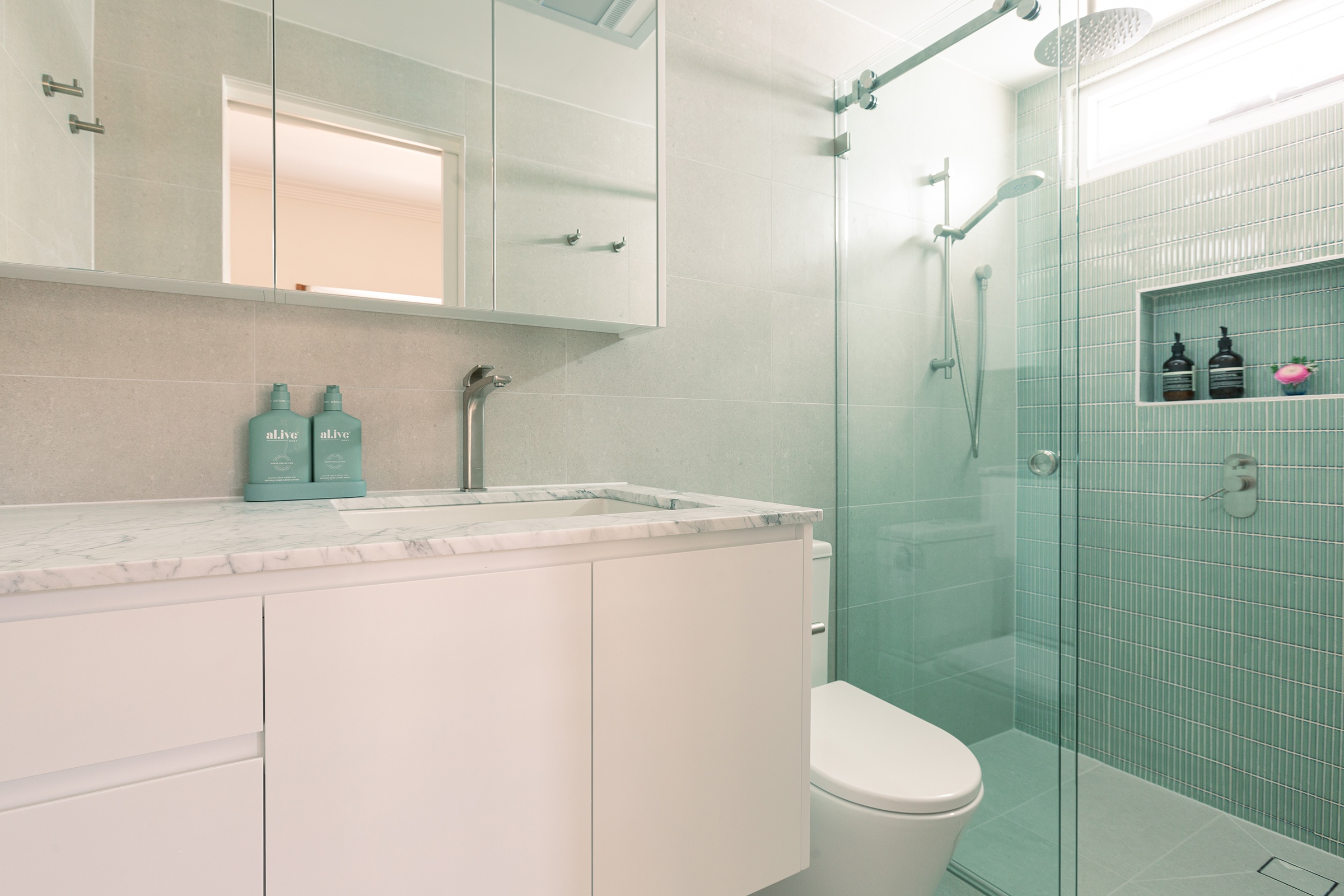
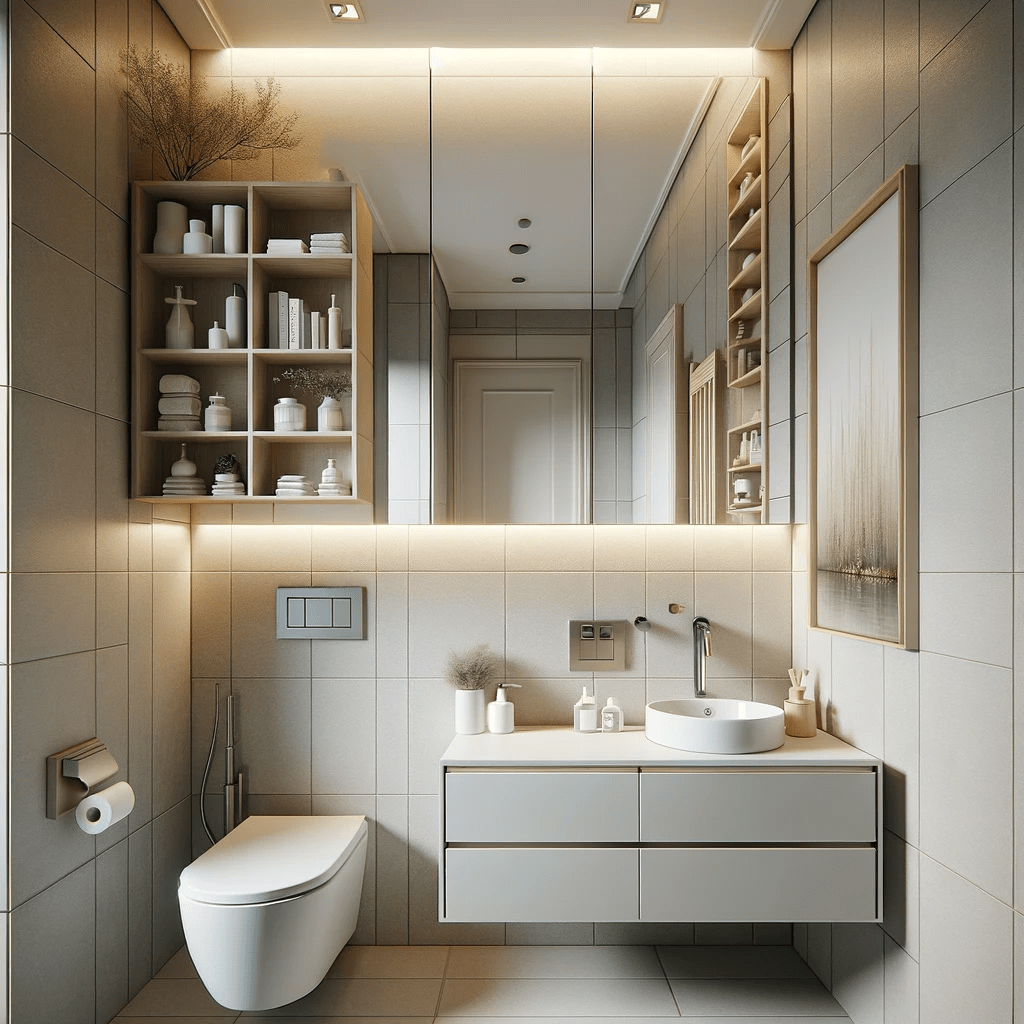
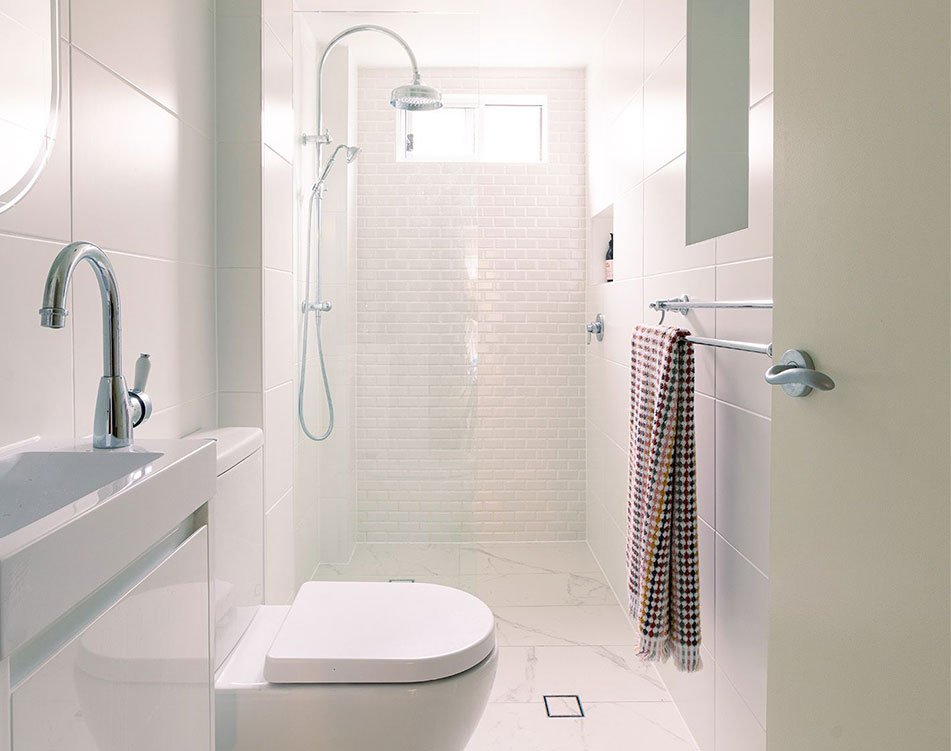 Types of Compact Tubs and Showers:
Types of Compact Tubs and Showers: Strategies for Maximising Vertical Space:
Strategies for Maximising Vertical Space: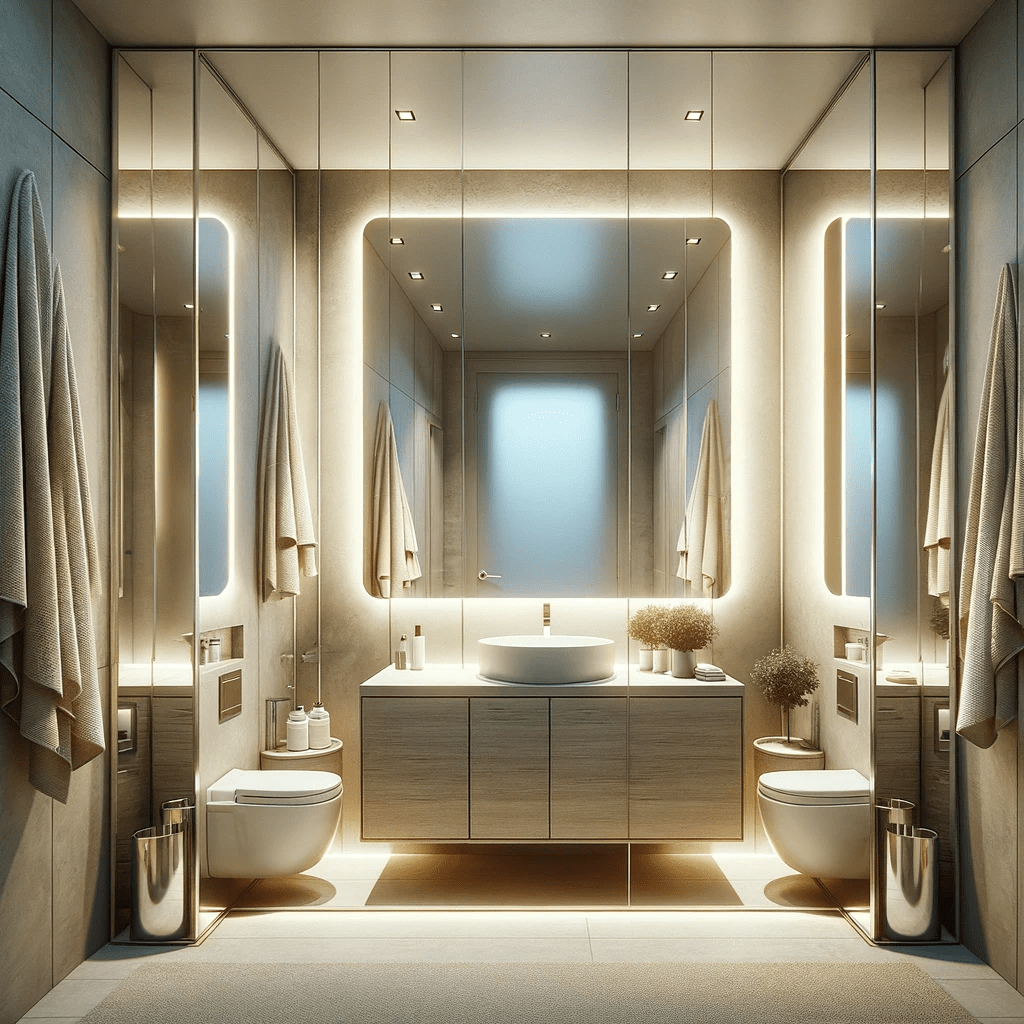
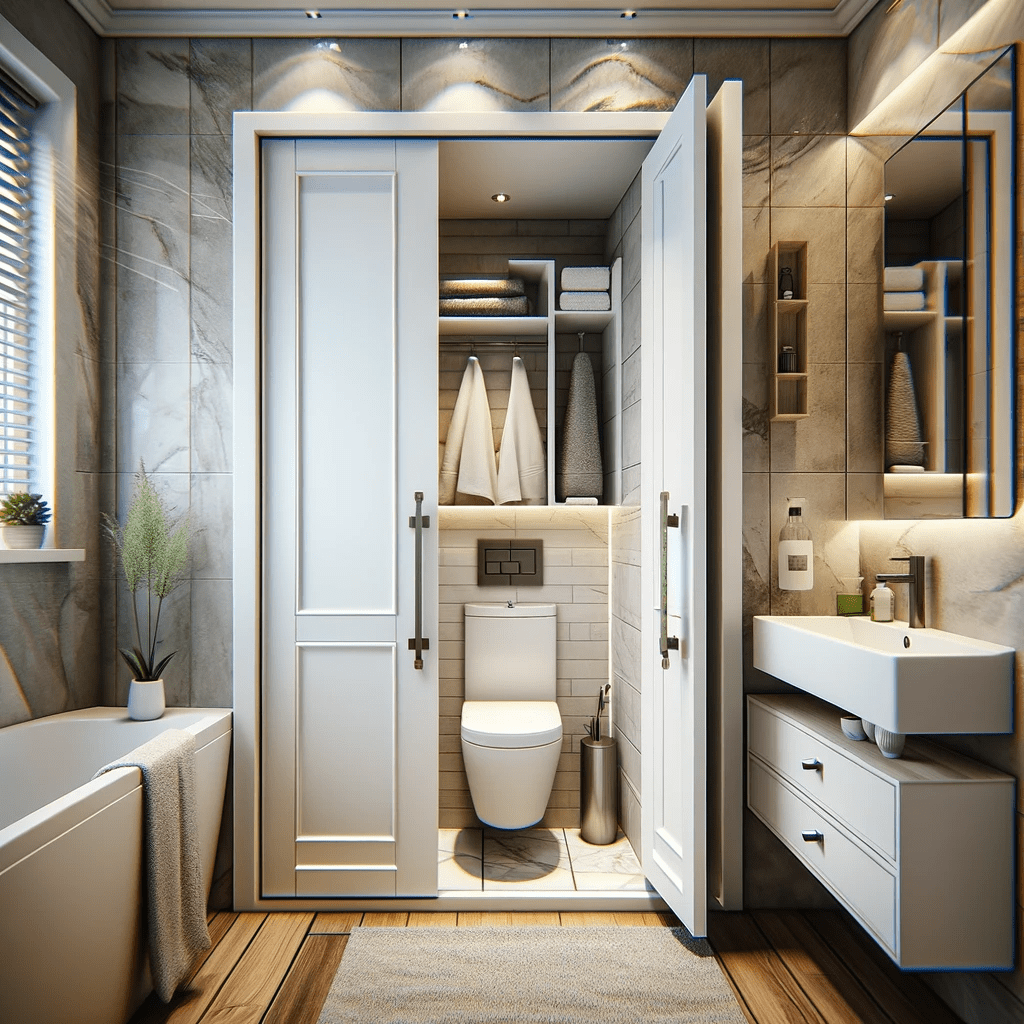
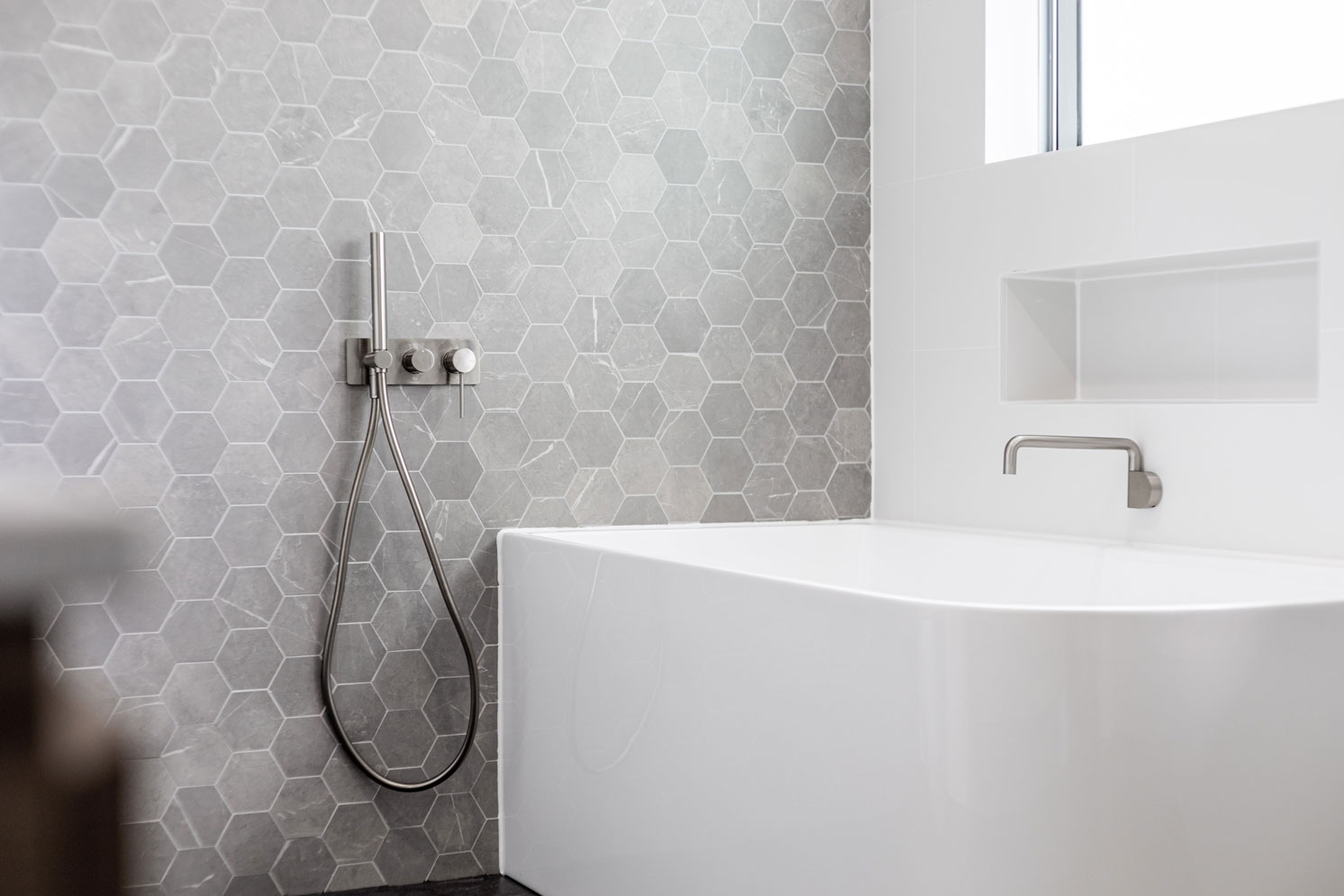 Benefits of Light Colours:
Benefits of Light Colours: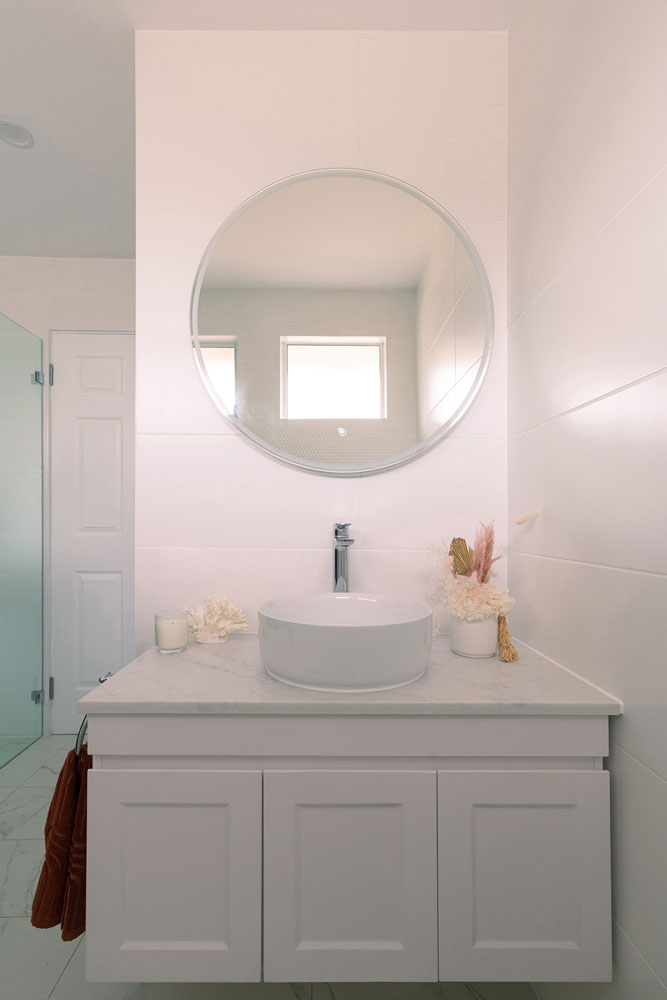
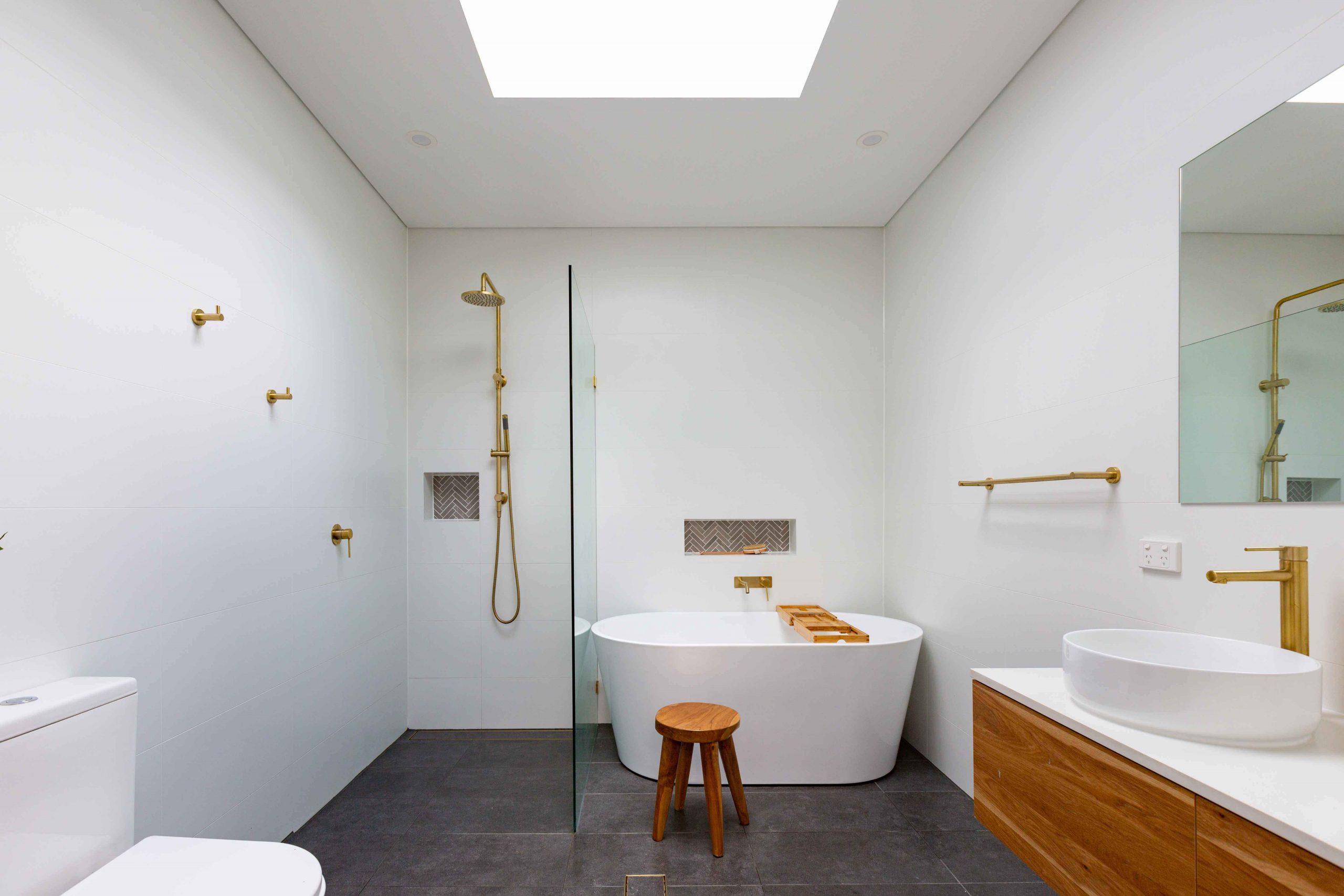 Innovative Hidden Storage Solutions:
Innovative Hidden Storage Solutions:


